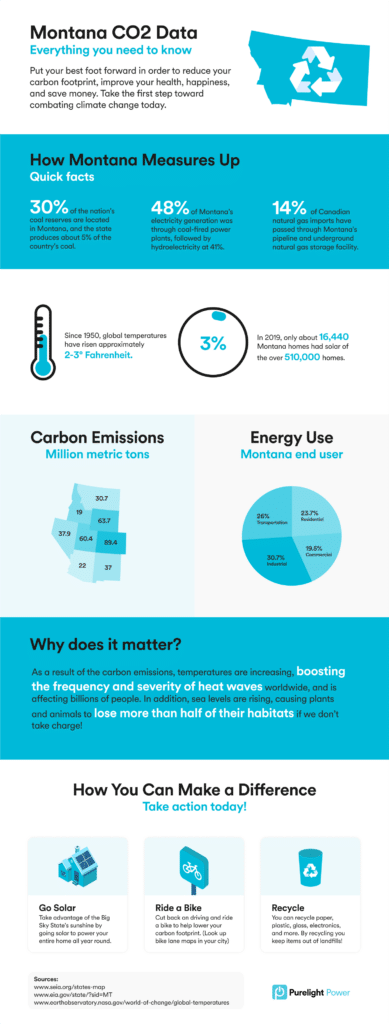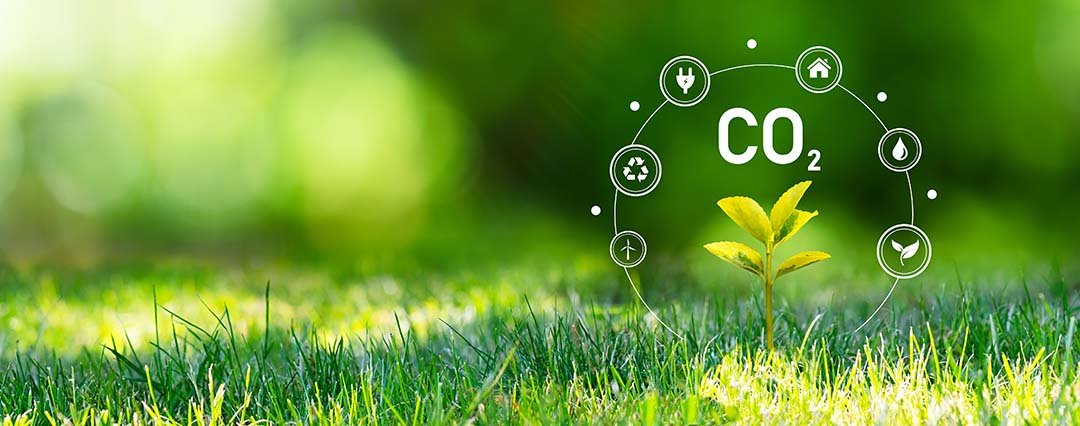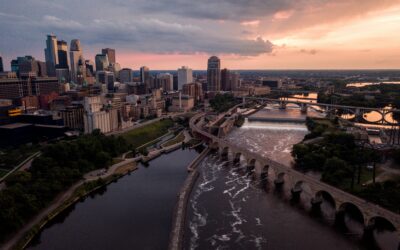Did you know that your day-to-day lifestyle choices have an impact on the climate? Possibly a more significant impact than you think. The residue that your daily habits leave behind is known as your carbon footprint.
In just 2017 alone, Montana residents emitted over 30,000,000 metric tons of CO2.
Admittedly, our lovely Montana state isn’t nearly as bad as Texas, which emitted 706,000,000 metric tons. But that doesn’t mean that every homeowner can’t do their part to keep our state high, wide, handsome, and green.
How can you start reducing the CO2 emissions you’re responsible for? Keep reading as we go over everything you need to know to start reducing your carbon footprint and make a difference in combating climate change in Montana.
What is a Carbon Footprint?
The phrase “carbon footprint” may sound strange, but it’s a concept anyone can understand.
A carbon footprint is the amount of carbon dioxide (CO2) released by a specific person, event, business, activity, location, or creation of a product.
For example, the burning of fossil fuels, clearing land of trees and plants, and the production and transportation of food, industrial goods, clothing, and lumber emits greenhouse gases, such as CO2 and methane.
Just an FYI, throughout this article we’ll be using a variety of terms, including carbon emissions, greenhouse gases, and CO2. These various terms are all referring to the release of CO2 in a way that can negatively impact our environment.
Does Carbon Footprint Matter in Montana?
While carbon has always been a part of our planet, excessive emissions of CO2 aren’t a great thing if we want to keep our planet livable. Given that we only have one habitable planet, it’s our responsibility to take care of it and ensure it can support life now and in the future.
Like other greenhouse gases, CO2 absorbs radiation and prevents heat from escaping from our atmosphere. High CO2 levels in the atmosphere collect and store too much heat, causing weather patterns to drastically change as global temperatures soar.
Across the Mountain West, we’ve already seen the dangers of these changes including worsening wildfires and flooding.
Montanans can work together and make simple changes like going solar to combat climate change rising to a dangerous point.
How Montanans Can Reduce Their Carbon Footprint
Driving a car and heating one’s home are the two most common ways Montanans contribute to increased climate change. Indirectly, we all also contribute to greenhouse gas emissions by purchasing goods and food from other countries or states that need to be transported long distances.
All of these emissions add up and have an impact on global climate change.
But don’t stress! We have the top 3 ways people in Montana emit carbon emissions in their everyday lives below, along with some ways to reduce your impact.
Like going solar with Purelight Power, we’ve kept these changes simple so you can easily adopt them in your daily life.
1. Switch Where You Get Your Electricity From
Purchasing electricity from power companies like Northwestern or Montana-Dakota is often a convenient way to power your home or business. Which is why most people in Montana rent their power from the utility company.
But renting power through a utility company that uses coal or natural gas to generate energy isn’t the only option for powering your home. Many Montanans are taking it into their own hands to reduce carbon emissions by using clean energy methods such as solar.
More solar in Montana means more clean energy jobs, and less mining that can destroy the natural beauty of Montana.
When you use a solar energy system for the first 5 years, you only emit about 50 grams of CO2 per kilowatt-hour. When compared to coal-fired power plants, the footprint of solar panel is 20-fold lower.
2. Save the Planet, Ride a Horse (or Drive an Electric Car)
Transportation emissions, particularly those from trucks and passenger cars, are the primary reason for Montana’s high emission rates. In 2018, Montanans emitted approximately 8,100,000 million metric tons of carbon dioxide from transportation alone.
According to the DEQ, transportation emissions totaled nearly 26 million metric tons of carbon dioxide equivalent in 2017, a more than 20% increase over past years.
There are three main ways to reduce those emissions: increasing the rate of electric vehicle conversion, significantly increasing public transit, and modifying urban design to support electric vehicles, bikes, walking, and public transportation.
Even companies in the auto industry, including pioneers Ford and Dodge, are making the transition to electric vehicles in support of reducing emissions.
Not yet in a position to purchase an electric vehicle? You can still reduce your carbon footprint by walking, riding your bike, or opting for public transit when possible. Montana is known for its pedestrian paths, which provide ample pavement and soft paths throughout the state, making walking an attractive choice for getting around and enjoying the beautiful outdoors.
3. Reuse Goods
Consider reusing what you already have if you can, which saves money in addition to being better for the environment. Using fewer single-use products means generating less waste and emitting less CO2 in the process of making and disposing of them.
Some ideas for reducing through reuse in your daily life:
- Get home goods and clothes at consignment and second-hand stores
- Save on the 5¢ bag fee at stores by bringing reusable shopping bags
- Reuse glass containers for storage, drinking vessels, vases, and more
- Don’t toss those scraps from cooking and meal leftovers – compost them
Join Montana in Reducing CO2 Emissions
Since 1950, temperatures in Montana have increased about 2-3ºF due to the release of harmful greenhouse gases in our earth’s atmosphere.
A warmer climate will increase the number and severity of wildfires, flooding, crop loss due to extreme weather conditions, and adverse effects on human health if we do not put our best foot forward to stomp climate change.
Montana Climate Solutions Council (MCSC) was tasked in 2020 with creating a Climate Solutions Plan that includes strategic recommendations for preparing Montanans for climate impacts. Montana’s goal is to reduce greenhouse gas emissions and achieve net greenhouse gas neutrality for the state’s estimated yearly electric loads by 2035.
In order to work toward a greener future, MCSC has implemented a 10-year property tax exemption for homeowners who switch to solar energy to power their home, in addition to other cost-saving measures.
Solar Incentives in Montana
By going solar, Montana homeowners can save money while reducing their carbon footprint. Purelight Power is Montana’s local solar company providing homeowners with the choice to go solar for $0 down and $0 out of pocket.
In addition to going solar for $0 out of pocket with Purelight, Montana homeowners can also leverage the federal solar investment tax credit. This benefit is commonly referred to as the ITC, which stands for “Investment Tax Credit.” If you install your solar system right now, you will receive a federal tax credit equal to 26% of the cost of your solar panel system.
For instance, if your solar energy system costs $40,000, your federal solar tax credit would be $40,000 x 26% = $10,400, making the total cost for your system $29,600.
Still feel like a lot of money? Think of it this way, if your electric bill is $180 a month, and will increase on average 4% every year, in just 10 years you would have spent roughly $27,000 to rent electricity from the power company. Unfortunately, the federal tax credit will be reduced to 22% by the end of 2022, so if you’re looking to go solar, you need to act fast!

Clean Energy for a Healthy Montana
16,441 Montanans are already taking steps to reduce their carbon footprint by going solar – you can too!
Want to go solar for zero down and have a home powered by clean energy that you own? Take a quick 30 second survey to see if your roof qualifies now!
Purelight Power is here to help you gain your energy independence with simple, affordable solar.





